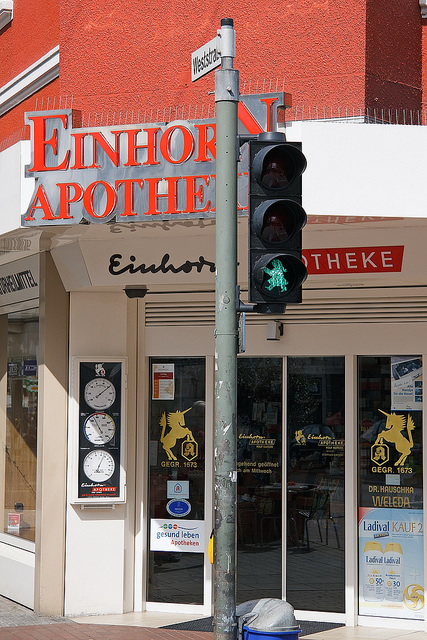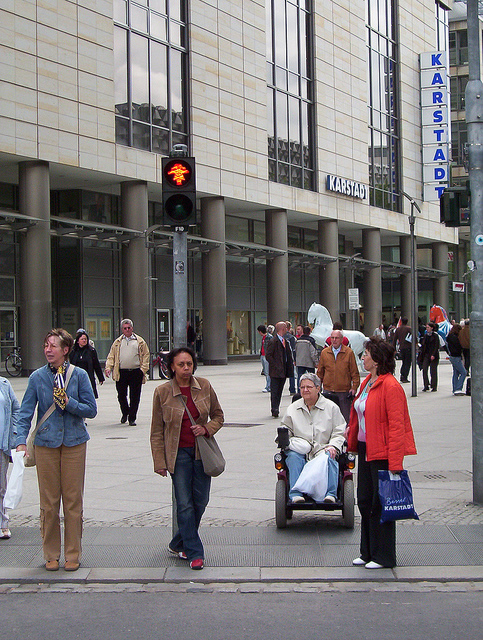German traffic lights strive for gender equality
If you ever doubted that people pay close attention to the signage around them, here’s proof that they do notice, and they really, really care: In a city in northwestern Germany called Dortmund, a decision to make a relatively innocuous adjustment to traffic lights has caused bitter division among residents and civic organizations alike.
The adjustment isn’t about making green mean “stop” and red mean “go,” though from the reactions, you might think the change was that disruptive. Instead, Dortmund officials are simply phasing in gender equality in the figurines on the “walk” signs. Instead of the traditional androgynous (though presumably male) figurines seen on walk signs around the world, Dortmund is moving toward a 50-50 balance between little green men and little green women.

The walking Ampelfrau. From Dirk Vorderstraße.
You might think such a change would be met with shrugs, if noticed at all. You’d be sorely mistaken. While some applaud the move, others are practically up in arms about it. Feargus O’Sullivan wrote about the unlikely controversy for a recent feature in City Lab.
O’Sullivan reports that a local newspaper “lampooned the potential silliness of the move.” Their (tongue-in-cheek) suggestion was to take things a step further and opt for “crosswalk couples” so no one could be offended by traffic light gender exclusion. (You can count “traffic light gender exclusion” high on the list of “things I never thought I’d write.”)
Germany’s Christian Democrat Young Union called the move a “senseless…world-improvement daydream.” Ouch.
Some people take issue not with the push for gender equality, but rather with the proposed female symbol. Described as a “squat, girlish figure with pigtails and a broad skirt,” the symbol already has a name: Ampelfrau. That translates, creatively, to “traffic light woman.”
The Ampelfrau is not an invention of Dortmund. She has actually been around for about a decade, mostly in eastern Germany. In several places, she is the one and only symbol on a city’s traffic lights. And, yet, when it was proposed that the Ampelfrau be introduced to traffic lights in the bustling city of Berlin, Berlin’s senate resoundingly shot down the idea, in O’Sullivan’s words, “deeming her pairing of Pippi Longstocking braids and a swinging skirt as an outdated cliché.”

This Ampelfrau indicates that pedestrians should stop. From Francisco Gonzalez.
Those responsible for the Berlin ruling also suggested that having one, uniform symbol on all traffic lights could be safer. Why? Because pedestrians and drivers are less likely to be distracted by a universal symbol than they might be if there were compelling variation in the symbols. (Yes, that was actual logic used in their ruling. See—we told you people pay attention to signage!)
One argument that can’t be made against Dortmund’s gender equality initiative? Wasted cost. Rather than simply replace 50 percent of the city’s walk signals with the Ampelfrau, they intend to wait until the lights naturally burn out and replace burned out lights with the Ampelfrau until they’ve achieved 50-50 balance.
O’Sullivan says that, overall, “the country remains divided as to weather the Ampelfrau is a sensible strike for gender equality, a silly PC sideshow, or an unwelcome throwback to a retrograde vision of femininity. For outsiders looking in, the discussion seems like more evidence of Germans’ love for “sweating the small stuff.”
We bet you’ll never look at a pedestrian walk signal the same way again.
